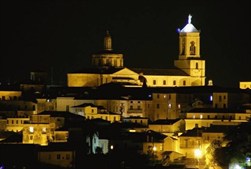Cittanova and Catanzaro
 During the Baroque period some cities were founded which still are on Calabria’s political and administrative map. Palmi (founded with the name Carlopoli), Isola, Pianopoli (founded as Feroleto Inferiore), Giffone, Carlopoli and Piminoro are only some examples, along with the city centre of Cittanova. Casalenuovo (this was its original name, which changed in the second half of the nineteenth century) was built from 1616 onwards at the orders of the feudatory Girolamo Grimaldi, who was obliged to guarantee the peasants on his lands who had fled from a preceding village on account of earthquakes and the plague. Cittanova increased in size and population during the course of the seventeenth century, but the seismic events at the end of the century required the reconstruction of a great part of the city. The existing towns then underwent important changes during the Baroque period due to natural events, to the need to defend them (especially cities which suffered attacks by pirates), to the expansion of Religious Orders after the Council of Trent, or also thanks to recently ennobled families who had palaces and religious buildings erected in their fiefs (of which there are still vestiges above all in the smaller towns). Catanzaro, for example, was a flourishing centre of silk production, during all of the early modern period, on account of which it enjoyed a series of privileges and statutes: in particular, in March 1519 Charles V authorised the creation of the Consolato dell’Arte della Seta (the Guild of silk producers). The Emperor himself granted the city the right to display the image of the eagle and the moto Sanguinis effusione due to the heroic resistance shown against the French and Venetian troops led by Lautrec in 1528. A protagonist of the Revolutionary episodes of 1647-1648 when the populace rose up to the cry of Fuori le gabelle (Down with taxes), Catanzaro altered its appearance, especially between the sixteenth and seventeenth centuries when many religious Orders settled there. The Jesuits arrived in the city in 1560 but few remnants of their presence there are to be found: their College in Catanzaro was demolished in the second half of the nineteenth century.
During the Baroque period some cities were founded which still are on Calabria’s political and administrative map. Palmi (founded with the name Carlopoli), Isola, Pianopoli (founded as Feroleto Inferiore), Giffone, Carlopoli and Piminoro are only some examples, along with the city centre of Cittanova. Casalenuovo (this was its original name, which changed in the second half of the nineteenth century) was built from 1616 onwards at the orders of the feudatory Girolamo Grimaldi, who was obliged to guarantee the peasants on his lands who had fled from a preceding village on account of earthquakes and the plague. Cittanova increased in size and population during the course of the seventeenth century, but the seismic events at the end of the century required the reconstruction of a great part of the city. The existing towns then underwent important changes during the Baroque period due to natural events, to the need to defend them (especially cities which suffered attacks by pirates), to the expansion of Religious Orders after the Council of Trent, or also thanks to recently ennobled families who had palaces and religious buildings erected in their fiefs (of which there are still vestiges above all in the smaller towns). Catanzaro, for example, was a flourishing centre of silk production, during all of the early modern period, on account of which it enjoyed a series of privileges and statutes: in particular, in March 1519 Charles V authorised the creation of the Consolato dell’Arte della Seta (the Guild of silk producers). The Emperor himself granted the city the right to display the image of the eagle and the moto Sanguinis effusione due to the heroic resistance shown against the French and Venetian troops led by Lautrec in 1528. A protagonist of the Revolutionary episodes of 1647-1648 when the populace rose up to the cry of Fuori le gabelle (Down with taxes), Catanzaro altered its appearance, especially between the sixteenth and seventeenth centuries when many religious Orders settled there. The Jesuits arrived in the city in 1560 but few remnants of their presence there are to be found: their College in Catanzaro was demolished in the second half of the nineteenth century.
